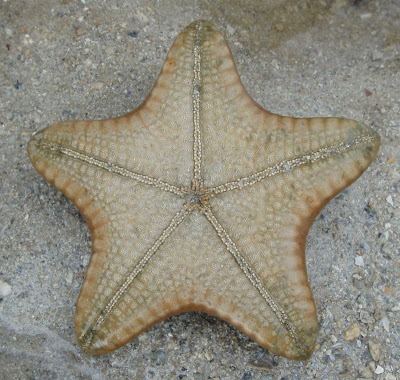Why swim? That's because we were 'puffer fishes'. hahaha... Puffer Fish was our group name la (in Singlish terms).
Anyway, they were there today as part of the training for Project Semakau (a three year project to collect data on Semakau)
More information of this project can be found on: http://projectsemakau.rafflesmuseum.net/
So, after a long foreword or whatever the above is called, let's get down to our first 'discovery' of the day, the common sea star (picture below).

Discovery Note:
1. Their tube feet are interesting as they are used for walking, handle food as well as breathing, and probably to catch prey as well, talk about multi purpose!
2. Sea stars get stressed when out of water, this is because while we have blood circulating our bodies, they have sea water circulating their bodies.
3. They are not as common as their name suggests. This is due to past over-collection and habitat lost past and present. So don't take them away from their homes when you see them. =)
4. Some sea stars are predators that prey on worms, crustaceans and bivalves while some are known to eat decayed plant matters.
5. Many sea stars eat with their stomach outside their body. When doing this, their tube feet will pull the two shells of a bivalve apart. And while still attached to their prey’s body, they extend their stomach out through their mouths into the bivalve shell.
6. Read more about the common sea star on http://www.wildsingapore.com/wildfacts/echinodermata/asteroidea/archaster.htm.
The second 'discovery' was spotted as we crossed the seagrass meadows, a synaptid sea cucumber (picture below).
 Discovery Note:
Discovery Note:
1. This looks very different to the sea cucumbers you usually see.
2. Synaptid sea cucumbers don't have tube feet. Instead, they may stick to things with their hooked spicules which poke out of their soft bodies. This is why they stick to our hands if we touch them.
3. They have thin body walls and are fragile, so we should not handle them.
Well, a group photo along the trail through the seagrass meadow seems to be norm nowadays, so here's one (picture below).
 Third 'discovery' is this yet-to-be ID-ed sea star. We have been seeing this for the last few trips since it was first spotted. Hopefully, it will be there to greet us everything we visit the area =) (picture below)
Third 'discovery' is this yet-to-be ID-ed sea star. We have been seeing this for the last few trips since it was first spotted. Hopefully, it will be there to greet us everything we visit the area =) (picture below) Fourth 'discovery' is a spider conch (picture below)!
Fourth 'discovery' is a spider conch (picture below)!
 Discovery Note:
Discovery Note:
1. This is often overlooked as its topside is well camouflaged.
2. Their movement is like a pole-value action sequence. They make use of a curved, knife-shaped operculum attached to a long strong foot to 'hop' around.
3. They are listed among the threaten animals of Singapore due to development and over collection.
4. Read more about the spider conch on http://www.wildsingapore.com/wildfacts/mollusca/gastropoda/strombidae/lambis.htm.
Our hunter seekers today either had great sight or good luck or even both, as they found us two knobbly sea stars of different sizes! Fifth 'discovery' (picture below).
 Discovery Note:
Discovery Note:
1. Although they are often brightly coloured and covered with dangerous-looking knobs, nodules and spines, Knobbly sea stars are not venomous.
2. As they can grow up to a diameter of about 30cm, they are considered highlights for inter-tidal walks.
3. Read more about the knobbly sea star on http://www.wildsingapore.com/wildfacts/echinodermata/asteroidea/protoreaster.htm.
And here's the traditional group photos with them (pictures below)

 And here's one puffer fish who is attempting to kiss one of the knobbly sea star. I must say this must be the first time I saw anyone attempting to kiss one of these... haha... (picture below)
And here's one puffer fish who is attempting to kiss one of the knobbly sea star. I must say this must be the first time I saw anyone attempting to kiss one of these... haha... (picture below) And of course, evening walks are accompanied by sunsets (picture below).
And of course, evening walks are accompanied by sunsets (picture below). Here's the sixth 'discovery', a bohol nudibranch, Discodoris boholiensis (picture below).
Here's the sixth 'discovery', a bohol nudibranch, Discodoris boholiensis (picture below).
Discovery Note:
1. 'Nudibranch' means 'naked gills'. The name comes from the flower-like gills found on the back of many nudibranchs. These nudibranchs use the gills to breathe.
2. Nudibranchs are related to snails. Little baby nudibranchs are born with shells, but they lose them when they become adults.
3. Most nudibranchs are carnivores, they eat immobile or small, slow-moving prey. Examples are sponges, ascidians, hard corals, soft corals, sea anemones etc.
4. To protect themselves, some produce distasteful substances, toxins and even acids. They advertise this with bright warning colours. Others are camouflaged to match their surroundings. Those that eat colourful creatures such as sponges or corals, may themselves be colourful to match their prey. Being small and flat, they can also easily hide in narrow places.
5. Read more about the bohol nudibranch on http://www.wildsingapore.com/wildfacts/mollusca/slugs/nudibranchia/boholiensis.htm.
And as we walked back, we also came across a juvenile knobbly sea star! Wow (picture below)!
 Here's another photo as we cross the seagrass meadow on the way back (picture below). The picture is a bit bright due to the settings on my camera.
Here's another photo as we cross the seagrass meadow on the way back (picture below). The picture is a bit bright due to the settings on my camera. Here's an attempt on an 'artistic photo of our shadows (picture below). =P
Here's an attempt on an 'artistic photo of our shadows (picture below). =P And a photo from near the NEA building of the sunset and the mini bus going to pick up the rest of the groups at the entrance of the forest trail (picture below).
And a photo from near the NEA building of the sunset and the mini bus going to pick up the rest of the groups at the entrance of the forest trail (picture below). And a final group photo (picture below). Puffer Fishes, Puff Up! hahaha...
And a final group photo (picture below). Puffer Fishes, Puff Up! hahaha... Here's a BIG Thanks to all puffer fishes from me, you people were attentive and a great group! =D
Here's a BIG Thanks to all puffer fishes from me, you people were attentive and a great group! =D
























